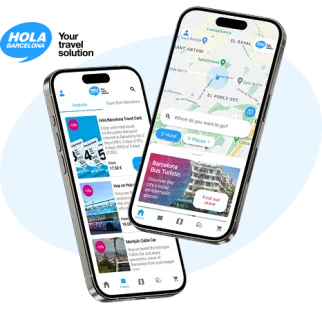Museum of World Cultures of Barcelona
An anthropological journey in two medieval palaces
Two medieval palaces on Carrer de Montcada are home to a museum that disseminates knowledge of other cultures. The Museum of World Cultures of Barcelona, which focuses on Africa, Asia, the Americas and Oceania, is located in the Palau del Marquès de Llió, which was constructed in the mid-13th century and subsequently expanded and renovated on numerous occasions, and at the Palau Nadal, a Gothic structure with Catalan Renaissance elements.

Barcelona Bus Turístic, on the Hola Barcelona app
Your app for visiting the city with the Barcelona Bus Turístic: routes, stops and the most iconic places. A comfortable way to carry your tickets too!
Why visit the Museum of World Cultures of Barcelona?
The origins of the Museum of World Cultures of Barcelona lie in the Barcelona Ethnological Museum and the collection that the businessman and collector Albert Folch gave to the city of Barcelona. It is located on the site of the old Barbier-Mueller Museum of Pre-Columbian Art, upon whose closure in 2012 the non-western collection of the Ethnological Museum was transferred to two palaces on Carrer de Montcada.
Palau del Marquès de Llió or Casa Mora is a building with a ground floor, two upper floors and an internal courtyard. On the main facade there is a tower that is one storey higher than the rest of the building, which still preserves architectural remains from the 13th century. The palace was expanded and modified several times until the 18th century, including the addition of windows and a staircase to the first floor, which was constructed in 1705 when it was acquired by the Marquis of Llió, Josep Francesc de Móra i Catà.
Palau Nadal, from the 14th century, is also a building with a ground floor and two upper floors, but it additionally incorporates a covered gallery supported by columns, an architectural resource common to other houses on Carrer de Montcada. On the facade there is a window from the 16th century with the bust of a man and a woman, possibly Bartomeu Bruc and his wife, who bought the house in 1546.
These two palaces, located opposite the Picasso Museum of Barcelona, are today the site of a museum that exhibits pieces from a diversity of cultures in Asia, Africa, the Americas and Oceania. They include, for example, figures from the Fang culture of Equatorial Guinea, Yoruba sculptures, Mayan ceremonial axes, Nazca pottery, Javanese shadow puppets, Buddha sculptures, and Rapa Nui wooden pectoral ornaments.
How do you get to the Museum of World Cultures of Barcelona?
The Museum of World Cultures of Barcelona is located on Carrer de Montcada, which you can access from the Pla de Palau – Parc de la Ciutadella stop or the Barri Gòtic stop on the Red Route of Barcelona Bus Turístic.
For the most curious of you
- Did you know? The Museum of World Cultures of Barcelona is one of the eleven members of a network of museums of ethnography and world cultures called SWICH (Sharing a World of Inclusion, Creativity and Heritage). It is a European cultural cooperation project whose aim is to strengthen the role of these museums as centres for creation, cultural encounters and knowledge production.
- Local’s tip: The museum is on one of Barcelona’s medieval and Catalan Renaissance streets, which are worth exploring to discover their palaces.
- A must: To see the artistic and cultural diversity of the various peoples of Africa, Asia, the Americas and Oceania.










